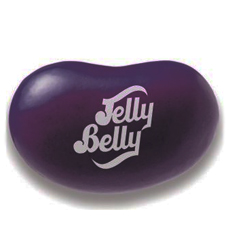| This past Sunday, Monday and Tuesday, we tripped the light fantastic* (actually, lumbered around on a very hard concrete floor) of the Jacob Javits Center in New York City, along with some 24,000 other attendees in search of the newest specialty foods—140,000 were on display.
Usually we do a Best of Show list—and we’ll get to it over the weekend—but there was one standout as Strangest Of Show. That award goes to the new jelly bean Superfruit Mix from Jelly Belly, “sure to be a best super seller. Order today and take advantage of the hottest trend in today’s market.”
*The phrase, “trip the light fantastick,” was first published by John Milton in his 1645 poem, “L’Allegro.” Unlike its meaning in the acid culture of the 1960s, in the 1600s, “tripping” meant to dance. Light meant you were dancing nimbly, and fantastick was a compliment to the skill of the dancer. |
|

The açaí-flavored Jelly Belly. Earth to consumers: There is no antioxidant health benefit in “superfruit” jelly beans. |
| In fact, Jelly Belly took out a full page ad on the back page of the show directory, reminding retailers that forecasts peg the superfoods category as a $10 billion global industry by 2011, and Jelly Belly is poised to help them “capitalize on this fast-growing trend with their Superfruit Mix. Several thousand new superfruit products entered the marketplace in 2007-2008….Superfruits like the new, trendy Acai [sic] berry is at the center of this trend….as consumers increasingly turned to its juice for a delicious gulp of nutrients and antioxidants. On top of the trends as always, Jelly Belly has included Acai in their new Superfruit Mix.”
Ahem—is there a disconnect here? Consumers drink açaí juice for its antioxidants, but nobody except the truly delusional would eat jelly beans for the implied, although never stated, “nutrients and antioxidants.” This is the equivalent of a taffy company saying that, “Green tea is at the height of consumer interest, and our green tea-flavored taffy is poised to help you capitalize on consumers’ focus on green tea.” Are we that much of a self-deluding group of consumers?
The ad goes on to report that the açaí berry—the proper spelling and capitalization; for the record, the pronunciation is ah-sigh-YEE—was the overwhelming winner of last year’s Jelly Belly Dream Bean contest. Yes, 18,000 consumers voted to make it the new Jelly Belly flavor. It’s the headliner of the new Superfruit Mix, which “features real fruit juices and purées from Acai Berries, Barbados Cherries, Blueberries, Cranberries and Pomegranates….”
A little grounding in reality: You need to eat the pure fruit or its juice in order to get your dose of antioxidants; you won’t find them to any efficacious degree in a fruit-flavored ice cream, salad dressing, soda or jelly bean. While fruit and fruit juice are high in natural sugars, the refined sugars in the flavored, processed foods that tout “superfruits” (or green tea or anything else that has healthy coat tails) smack of P.T. Barnum marketing (“There’s a sucker born every minute”). The refined sugars in jelly beans will more than offset any superfruit value a consumer might hope would be there. (A 1.2-ounce serving of Jelly Belly has 140 calories, 0g fat, 0g protein, 37g carbohydrate of which 28g are sugars, and 10mg sodium. How much antioxidant power do you think is in the superfruit juice/purée flavoring? Not enough for any claims of efficacy, that’s for sure!
Of course, Jelly Belly has not made any claims of efficacy. But by co-opting the name “superfruit” for their product, they imply more than just the flavor of superfruits. Otherwise, call it Açaí-Cranberry-Pomegranate Mix. This way, you’re pulling the wool over the eyes of the sheep.
|

